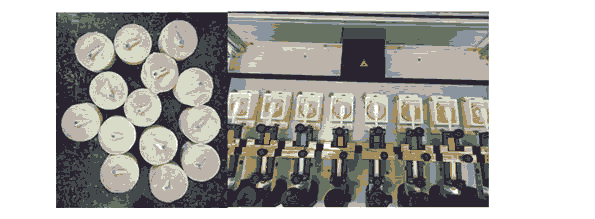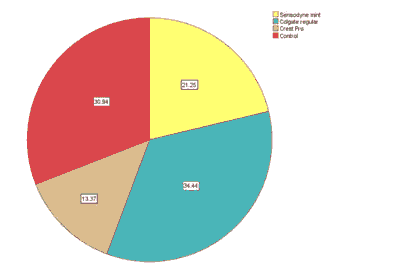Commentary Article - (2021) Volume 9, Issue 12
Shear Bond Strength Assessment of Orthodontic Brackets Subjected To Brusing with Dentifrices with Different Dentin Abrasivity Index- An In Vitro Study
Preethi Rajamanickam* and Ravindra Kumar Jain
*Correspondence: Preethi Rajamanickam, Department of Orthodontics, Saveetha Institute of Medical and Technical Sciences, Chennai, India, Email:
Abstract
Regular tooth brushing with dentifrices is needed to maintain oral hygiene and prevent decay. Currently, the abrasives frequently used in toothpastes include precipitated silica, calcium carbonate, alumina, and a variety of calcium phosphates. Commercially-available dentifrices with miscellaneous ingredients are commonly used by orthodontic patients. Some of these ingredients can induce alterations around orthodontic brackets. Since ancient times, the incorporation of abrasive powder in toothpastes or powders has been carried out, previously materials such as bone ash (which is mainly composed of ß-tricalcium phosphate3), coral, shell, marble or pumice powders. Abrasives (also called cleaning and polishing agents) are intentionally added to toothpaste to remove surface stains and break up bacterial colonies. Nowadays, the most commonly used abrasives are hydrated silica, dicalcium phosphate, calcium carbonate, and sodium metaphosphate and they account for one-third of the paste volume. Also, whitening pastes may contain more abrasives for polishing the teeth and breaking down or dissolving stains from daily food and beverage consumption [1].
Keywords
Relative dentin abrasion, abrasives, miscellaneous ingredientsIntroduction
Nowadays, the most commonly used abrasives are hydrated silica, dicalcium phosphate, calcium carbonate, and sodium metaphosphate and they account for onethird of the paste volume. Also, whitening pastes may contain more abrasives for polishing the teeth and breaking down or dissolving stains from daily food and beverage consumption. Relative dentin abrasion (RDA) gives the abrasivity values of a dentifrice. Any number below 250 is considered to be a safe dentifrice for daily use, meaning an RDA value of 100, 150, or even 250 would be considered equally safe for daily use. Several studies have been conducted to evaluate the abrasion of both dentifrices and toothbrush filaments. Pascaretti-Grizon et al used Vertical Scanning Interference microscopy to analyze the abrasivity of 6 different dentifrices and concluded that tooth pastes showed lesser abrasivity compared to tooth powders. And concluded that the whitening toothpastes increased the surface roughness of the composites. Barbieri et al studied the influence of whitening dentifrices compared to a non-whitening dentifrice on the surface roughness of commercial composites and reported that the whitening toothpastes caused higher surface roughness in the composites compared to the non-whitening type [2]. Thus the aim of the present study is to report about the effect of commercially available dentifrices with varying relative dentin abrasivity (RDA) on the shear bond strength of metallic orthodontic brackets.
Materials and Methods
The study was conducted at the material lab, Saveetha Dental College and Hospitals. 24 sound premolars, extracted for orthodontic reasons, were obtained for the study. The teeth did not have any visible cracks, hypoplasia, white spots, caries, or restorations on the labial surfaces. They were washed in water to remove contamination and stored in distilled water in a refrigerator (i.e., nominal 4?) for 1 month, in accordance with the ISO/TS 11405 standard. In accordance with the protocol described the labial enamel surfaces were cleaned, polished, and etched. 23 A thin uniform coat of primer (Transbond XT; 3M Unitek, Monrovia, CA, USA) was applied by using a microbrush. Metallic brackets (MBT 3M Unitek) were then placed on the teeth, adjusted to their final positions, and pressed firmly.
After removing excess resin from the periphery of the bracket base with a dental probe, the adhesive was cured by using a light-emitting diode light source (Woodpecker ILED Light Curing Unit) for 6 s (3 s mesially and 3 s distally), according to the manufacturer's instruction [3].
Mounting procedure
After storage in distilled water at 37? for 24 h, the teeth were embedded in die stone (35-mm diameter and 20- mm height) exposing the labial surface of the tooth with the bracket bonded Fig 1a. Samples were adapted to a brushing machine Mechatronik toothbrush simulator ZM3.8 that simulated a two-year brushing period with a force of 200 N, frequency of 10 RPM, and 20,000 cycles of brushing movements Fig 1b.
In an attempt to replicate all types of brushing movements, 5000 cycles of brushing in all directions are carried out alternatively (5000 cycles in anticlockwise direction, 5000 in clockwise direction, 5000 in horizontal motion and 5000 vertical strokes). The samples were subjected to brushing and those in the control group were then subjected to bond strength assessment.
The bond strength was evaluated with a mechanical testing machine (Instron 3380 Series Universal Testing Systems up to 100 kN (22,500 lbf) Force Capacity) Figure 2., operated by a trained, blinded researcher. The machine speed was set at 1.0 mm/min, the recording speed was maintained at 20 mm/min, and the scale was set at 50 kg.24 The force needed to disrupt the orthodontic bracket bond was verified for each sample.
Figure 1: Samples mounted in die stone; b) Samples loaded in a brushing simulator.
Figure 2: Sample loaded in a universal testing machine (Instron.
Statistical Analysis
SPSS version 23 was used for statistical analysis. The data was found to be parametric after performing the Shapiro- Wilk test of Normality (Table 1), one-way ANOVA was done to test the significant differences between groups [4].
| Mean square | Significance | |
|---|---|---|
| Between groups | 27.92 | 0 |
| Within groups | 0.56 | - |
Results
The power of the study is calculated using G-Power 3.0 software and the power of the study was found to be 85%. Significant differences were observed for mean shear bond strength between Group 1 , Group 2 (RDA=63), Group 3 (RDA =70) and Group 4 (RDA=100). Bond strength of the brackets after subjecting to brushing stimulation with dentifrices having different RDA was found to be higher in Group 2 followed by the Group 1, Group 3, and was least in the Group 4, and the differences were statistically significant ( p value<0.05).
Mean bond strength for Group 1, Group 2, Group 3 and Group 4 were 7.2+/-1.05, 7.7+/0.24, 4.88+/-1.01 and 3.1+/-0.26 respectively. Significant intergroup differences were found (p- value<0.05) except between Group 1 and Group 2 [5].
Figure 3: Pie chart showing the distribution of mean shear bond strength between the 4 groups.
Discussion
This study was done to evaluate the effect of commercially available dentifrices with varying relative dentin abrasivity (RDA) on the shear bond strength of metallic orthodontic brackets. 3 dentifrices were involved in the study with low, medium and high relative dentin abrasivity indices and a control group was also included which was subjected to brushing, but without a dentifrice with the same toothbrush (Sensodyne daily care toothbrush). In the present study, SBS of the orthodontic brackets showed a significant difference between the 4 groups and the bond strength among the test groups was highest for Group 2 whereas Group 4 exhibited lowest SBS value compared to other groups. However the mean shear bond strength of the Colgate regular group was higher than the control group and the difference was not statistically significant. The study results suggest that relative dentin abrasivity and the type of the abrasive influences the shear bond strength of orthodontic brackets. The results obtained in this study are in agreement with another study, which reported whitening toothpastes negatively influenced the SBS after simulated brushing. In contrast, a study assessed the SBS of resin composite to human enamel after using a whitening toothpaste and reported whitening toothpaste did negatively influence the SBS of resin composite. Changes in bond strength values may be related to the surface roughness and hardness of the enamel as the application of WT to enamel increased the enamel surface roughness and decreased hardness values.27. In previous studies, it was reported that bleaching agents decreased bond strength due to changes in the enamel in the form of increase in surface porosity. Moreover, some investigators reported the critical elements causing reduction of tensile strength to enamel such as a decrease in microhardness and loss of calcium after subjecting to bleaching procedure with carbamide peroxide. Previous study conducted compared the SBS of orthodontic brackets after subjecting to brushing with two different manual brushes and concluded that there was no statistically significant difference. However comparison of these study results with the present study is difficult as none of these studies compared the SBS of orthodontic brackets when subjected to brushing with different dentifrices. The results of our study showed that abrasivity of a dentifrice does influence the shear bond strength of metallic orthodontic brackets. Furthermore, the influence of whitening toothpastes on the bond strengths of teeth after shorter application time on the immediate and aged specimens was not tested in this study. Different brushing techniques could be employed thus studies correlating the technique of brushing and the dentifrices can be done.
Conclusion
Based on the results of the study, it can be concluded thatRelative dentin abrasivity of a dentifrice influences the bond strength of orthodontic brackets. Using dentifrices with higher abrasivity over a period of time can reduce the shear bond strength of orthodontic brackets and lead to bond failure.
References
- Hilgenberg SP, Pinto SCS, Farago PV, et al. Physical-chemical characteristics of whitening toothpaste and evaluation of its effects on enamel roughness. Braz Oral Res. 2011;25:288–294.
- Govindaraju L, Gurunathan D. Effectiveness of Chewable Tooth Brush in Children-A Prospective Clinical Study. J Clin Diagn Res 2017;11: ZC31–4.
- Christabel A, Anantanarayanan P, Subash P, et al. Comparison of pterygomaxillary dysjunction with tuberosity separation in isolated Le Fort I osteotomies: a prospective, multi-centre, triple-blind, randomized controlled trial. Int J Oral Maxillofac Surg 2016;45:180–185.
- Soh CL, Narayanan V. Quality of life assessment in patients with dentofacial deformity undergoing orthognathic surgery a systematic review. Int J Oral Maxillofac Surg 2013;42:974–980.
- Mehta M, Deeksha, Tewari D, et al. Oligonucleotide therapy: An emerging focus area for drug delivery in chronic inflammatory respiratory diseases. Chem Biol Interact 2019;308:206–215.
Author Info
Preethi Rajamanickam* and Ravindra Kumar Jain
Department of Orthodontics, Saveetha Institute of Medical and Technical Sciences, Chennai, IndiaCitation: Ravindra Kumar Jain , Preethi Rajamanickam, Shear Bond Strength Assessment of Orthodontic Brackets Subjected To Brusing with Dentifrices with Different Dentin Abrasivity Index- An In Vitro Study, J Res Med Dent Sci, 2021, 9(11): 186-191.
Published: 01-Nov-2021



